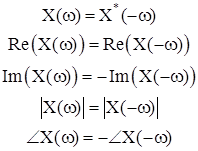Some Basic Functions |
|
x(t) |
X(ω) |
|
|
|
|
|
|
|
|
|
|
|
|
|
|
Derived Functions (using basic functions and properties) |
|
x(t) |
X(ω) |
|
|
|
|
|
|
|
|
|
|
|
|
γ(t) |
|
Using these functions and some Fourier Transform Properties (next page), we can derive the Fourier Transform of many other functions.
Information at http://lpsa.swarthmore.edu/Fourier/Xforms/FXUseTables.html
© 2015, Erik Cheever
Fourier Transform Properties
Name |
Time Domain |
Frequency Domain |
Linearity |
|
|
Time Scaling |
|
|
Time Delay (or advance) |
|
|
Complex Shift |
|
|
Time Reversal |
|
|
Convolution |
|
|
Multiplication |
|
|
Differentiation |
|
|
Integration |
|
|
Time multiplication |
|
|
Parseval’s Theorem |
|
|
Duality |
|
|
|
|
Symmetry Properties
x(t) |
X(ω) |
x(t) is real |
|
x(t) real, even |
|
x(t) real, odd |
|
Relationship between Transform and Series
If xT(T) is the periodic extension of x(t) then: Where cn are the Fourier Series coefficients of xT(t) and X(ω) is the Fourier Transform of x(t) |
Furthermore |

















